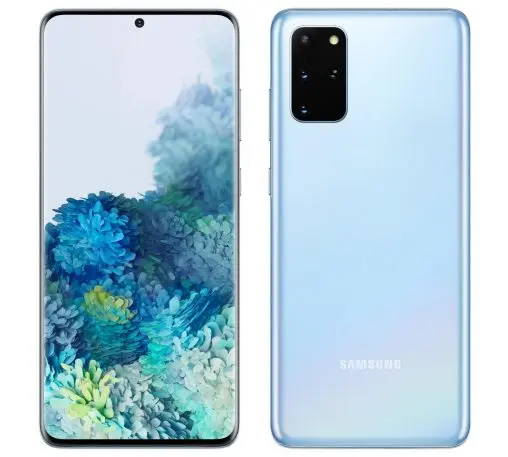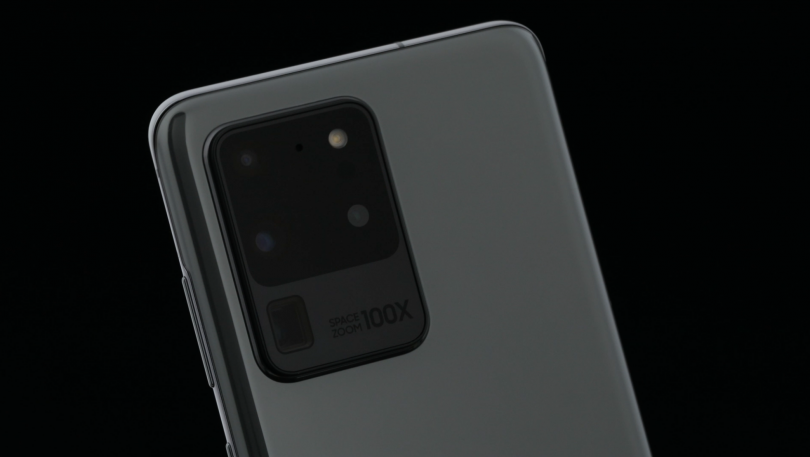The first thing to know about Samsung’s new Galaxy S20 phones is that they aren’t upgrades to last year’s Galaxy S10—at least not in the way that the S10 was an upgrade to 2018’s Galaxy S9, and so on all the way back to the original Galaxy S in 2010.
Instead, with the Galaxy S20’s launch today in San Francisco, Samsung is establishing a whole new hyperpremium tier of phones. In the U.S., for instance, the Galaxy S20, Galaxy S20+, and Galaxy S20 Ultra will all come standard with 5G connectivity, a feature that your current phone—be it from Samsung or anyone else—almost certainly doesn’t have. That in itself makes them part of the future of smartphones.
The S20 phones also have some of the most ambitious camera technology that anyone has ever stuffed into a phone. Their sensors are larger, and so are their megapixel counts and zoom ranges, by a lot—with up to a startling 108 megapixels of resolution and 100X zoom range in the case of the Galaxy S20 Ultra.
If you still can’t tell that the S20 phones don’t just slip into the same slots in Samsung’s lineup heretofore occupied by the Galaxy S10e, S10, and S10+, their prices will leave no doubt. Last year, the line started with the $750 S10e, which had a 5.8-inch screen. This year, the cheapest version, the Galaxy S20, has a 6.2-inch screen and goes for $1000. The 6.7-inch Galaxy S20+ is $1199. And the Galaxy S20 Ultra has a 6.9-inch screen—a skosh bigger than even the Galaxy Note10–and a truly budget-busting price of $1399. None of these phones count as direct rivals to Apple’s iPhone 11, which, at $700, sells for $50 less than the iPhone XR’s starting price in 2018.
Now, it’s not as if Samsung doesn’t want to sell smartphones to people who aren’t ready to plunk down a thousand bucks or more for the phone of their fantasies. Just last month, it introduced the Galaxy S10 Lite and Galaxy Note10 Lite, which are more affordable than the previous S10 models, which also remain on the market. The company also has a whole series of budget-priced Galaxy A phones that are widely available, though they aren’t marketed with a fraction of the Galaxy S series’s hoopla. Even the base Galaxy Note10 is cheaper than the Galaxy S20, in a striking departure from past pricing.
As for the Galaxy S20 line, it’s in part a reaction to the fact that plenty of people are still pretty happy with the phones they bought two or more years ago. When I got a preview of the S20 models from Samsung Mobile’s director of product management, Suzanne De Silva, she began her presentation by noting that upgrade cycles are slowing. In 2016, according to Samsung, customers held onto their phones for 22.2 months on average. By 2018, that was up to 26.6 months.
The strategy behind the Galaxy S20’s high-end aspirations? “Let’s give consumers a step-function reason to upgrade,” says De Silva.
The new phones are due to arrive on March 6. Samsung will begin taking orders on February 21, with inducement for preorders in the form of credits that buyers can spend on items such as accessories: $100 for the Galaxy S20, $150 for the S20+, and $200 for the S20 Ultra.

All screen and no headphone jack
As any attentive Samsung watcher could have predicted, the new Galaxy S20 models pick up on some of the design themes that the company introduced last August with the Galaxy Note10. Their fronts are just about all screen, shrinking even the modest top and bottom borders of last year’s S10 models to near-nothingness. Their front-facing cameras are now ensconced in a small, centered “hole punch” cutout that’s more elegant than an iPhone-style notch or the S10’s much wider rightward cutout. As with the Galaxy S10, the fingerprint scanner continues to be embedded under the display.
Oh, and in a move that we all knew was inevitable sooner or later, the headphone jack is gone. Samsung packs USB-C headphones in the box and will be happy to sell you a pair of its AirPods-esque wireless Galaxy Buds. (It’s introducing a new version, the Galaxy Buds+, with a lofty claim of 11 hours of battery life on a charge.)
These are some of the best-looking phones that Samsung or anyone else has made.
For some people, the 5G connectivity will be crucial. The Galaxy S20 supports “sub-6″ 5G, which isn’t astoundingly fast but lends itself to the widest coverage; the S20+ and S20 Ultra add support for” mmWave” 5G, which can deliver blistering speeds but requires carriers to pack a city with cells to make it work, making carrier deployments more laborious.
The very fact that a prospective Galaxy S20 buyer needs to pay attention to which type of 5G a particular version of the phone can handle is a sign that the technology is not yet a mainstream replacement for 4G. As 5G takes off, both flavors will matter. But even though 5G is already being marketed like it’s a miracle, you may or may not be able to get any type of it in your vicinity. And even if you can, there’s no guarantee it will be meaningfully more zippy than decent 4G.
Here in the Bay Area, for instance, only AT&T has rolled out 5G—in 4G-esque sub-6 form—at all. I can’t get it from my provider, T-Mobile, even though the “uncarrier” is already trumpeting its “nationwide” 5G network. Bottom line: 5G wouldn’t change my life in the immediate future, even if I owned a 5G phone.
None of this means that the Galaxy S20’s 5G is irrelevant. After all, you may well still be using the phone you buy in 2020 several years from now, when 5G will be far more widespread and a 4G-only phone will feel like an antique. The arrival of high-profile, appealing-looking phones such as these new Galaxys is a milestone for the 5G rollout that will help nudge the ecosystem forward.
But if you’re relatively happy with the smartphone you’ve got now, there’s no shame in holding off until 5G is more widespread and phones that support it are more affordable. For many folks, that’s a downright prudent course of action.
Camera extravaganza
Even if you’ve developed an immunity to 5G hype, you might get excited over the camera improvements Samsung is introducing with the Galaxy S20 line. Last year’s Galaxy S10 models didn’t futz much with the cameras from 2018’s Galaxy S9 phones—which wasn’t a catastrophe, since the S9 cameras remained impressive. Since then, however, Apple and Google have upped their photographic games with the iPhone 11 and Pixel 4, respectively. And Samsung has worked overtime to make its S20 phones stand out in a field where the standard level of quality is imposingly high.
All the S20 variants have three rear cameras—ultra-wide, wide-angle, and telephoto—and the S20+ and S20 Ultra add a depth camera that’s useful for tasks such as blurring the backgrounds on portrait shots. Samsung has increased the sensor size, which lets in more light and thereby improves performance in low light. Like the Pixel and iPhone, the S20 phones have a night mode that uses AI to brighten your shots in otherwise impossibly dim environments. On the video side, they can capture 8K video, with stabilization that Samsung says rivals what you’d get if you mounted your phone on a gimbal.

All the extra pixels of those sensors are less about raw resolution—12 MP is plenty for most purposes—and more about enabling a technology Samsung calls Space Zoom, which pushes the zoom range far beyond its optical limits. On the Galaxy S20 and S20+, maximum zoom is 30X, and on the S20 Ultra, it’s 100X—giant multiples for smartphone cameras. With so many pixels to play with, the phones can perform digital zoom by throwing away the pixels around the edges, without the pixilated results of other long-range smartphone zooms. A dash of AI enhances image quality further.
Or so it should go in theory. We’ll have to wait for real-world tests to know if all this technology delivers. For the record, when I fiddled with the Galaxy S20 Ultra at my briefing with Samsung, I found that I could capture images that looked decently crisp (at least on the phone’s own screen) at 10X, a level of magnification that usually results in a blurry mess. Zooming way beyond that, however, left me struggling to keep my hand steady enough for a sharp photo. I realized that smartphones, for all their wonders, aren’t as easy to grip as a nice, old-fashioned point-and-shoot camera.
Along with all the camera technological advances, the S20 phones have a new feature called Single Take that’s designed to let you offload the artistry of photography to Samsung’s software. You press the shutter button and move your phone around a bit—not to compose a particular shot, but to capture imagery from a variety of angles. The phone’s software then uses AI to slice and dice what you shot into a variety of still images and brief videos, attempting to pick pleasing shots (such as a moment when everybody’s eyes are open) and applying effects (say, a black-and-white filter). The quantity and specific nature of the results will vary each time, based on Single Take’s decisions.
It’s certainly possible that Single Take will join past Samsung innovations that turned out to be gimmicks rather than necessities—anyone remember the Galaxy S4’s Drama Shot?—but at first blush, it looks fun. Maybe even useful.
Less is more
Speaking of Samsung creating new software features, the S20 line has a few other examples, such as Music Share, which lets your phone serve as a middleman so that your friends can stream music from their own devices to your car stereo or wireless speaker. But the more significant piece of software news might be that Samsung says it isn’t going to try to build everything on its own. Instead, it wants to collaborate with other companies to integrate software and services that are already popular and polished. (An early example of this strategy is its partnership with Microsoft, announced at last year’s Galaxy Note10 event.)
Today’s Samsung seems more self-aware about the limits of its own software chops.
In general, today’s Samsung seems more self-aware about the limits of its own software chops. Bixby, its superfluous-feeling AI assistant, is still with us; a new feature lets it create Spotify playlists for you, in another instance of Samsung’s new yen for collaboration with existing services. But as with the Galaxy Note10, the dedicated Bixby button is gone, replaced by a power button that can double as a Bixby launcher—or not, at your discretion. The company also streamlined the new phones’ camera app, downplaying the irritating Bixby Vision machine-vision tool. (On previous Galaxy phones, I encountered the feature mostly through launching it by mistake.)
Ultimately, it feels like the features, technologies, and ideas seen in the Galaxy S20 phones will take more than one generation to play out. In 2017, the iPhone X—like the Galaxy S20, a $1000 phone—was a pricey outlier in Apple’s lineup, but it proved to be the model for all iPhones that followed, including the much more affordable iPhone XR and iPhone 11. Does Samsung have a similar road map in mind? It isn’t saying. But one thing is obvious: Phones with some of the S20 line’s spirit but more down-to-earth sticker prices would make a lot of people very happy.
Recognize your brand’s excellence by applying to this year’s Brands That Matter Awards before the early-rate deadline, May 3.